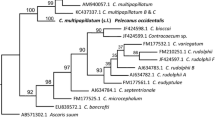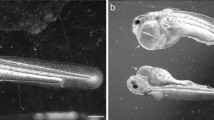Summary
-
1.
Two clones were cultured from Trichoplax adhaerens. One was isolated in 1969 (clone I), one in 1971 (clone II).
-
2.
With a certain population density a degenerative phase sets in, which consists of a reversible and an irreversible period. The animals die if they are not transferred to a fresh culture dish on time.
-
3.
Transition to the degenerative phase is the essential condition for the formation of eggs.
-
4.
Although in one of the clones (clone I) spontaneous formation of eggs occasionally occurred, oogenesis took place on a larger scale only if both clones were mixed together.
-
5.
The distinction between the two clones does not correspond to a sexual differentiation. Mixing both clones resulted in the induction of egg formation in clone II also, though it had not been observed to occur spontaneously in this clone.
-
6.
Sperm have not yet been definitely identified. However, the fact that only eggs which have secreted a special envelope (“fertilization membrane”) can develop further is indicative of the occurrence of fertilization.
-
7.
Cleavage is total and equal. Under the present conditions of culturing all stages of cleavage die sooner or later. The result of embryogenesis is therefore still unknown.
Zusammenfassung
-
1.
Von Trichoplax adhaerens wurden zwei Klone gezüehtet. Der eine wurde 1969 (Klon I), der andere 1971 isoliert (Klon II).
-
2.
Bei einer bestimmten Populationsdichte setzt eine degenerative Phase ein, die aus einem reversiblen und einem irreversiblen Abschnitt besteht. Werden die Tiere nicht rechtzeitig in eine frische Kulturschale übertragen, so gehen sic zugrunde.
-
3.
Der Übergang in die degenerative Phase bildet die wesentliche Voraussetzung für die Eibildung.
-
4.
Obwohl in einem der beiden Klone vereinzelt auch eine spontane Eibildung beobachtet wurde (Klon I), fand sic in größerem Umfang erst statt, wenn beide Klone miteinander vermischt wurden.
-
5.
Der klonale Unterschied entspricht keiner sexuellen Differenzierung; durch Vermischen beider Klone wurde auch in Klon II eine Eibildung induziert, indem sie bisher noch nicht spontan aufgetreten ist.
-
6.
Spermien konnten noch nicht eindeutig identifiziert werden. Far das Vorkommen einer Befruchtung spricht aber, daß sich nur Eier weiterentwickeln können, die eine besondere Hülle (“Befruchtungsmembran”) ausgebildet haben.
-
7.
Die Furchung ist total-äqual. Unter den derzeitigen Kulturbedingungen sterben alle Furchungsstadien früher oder später ab. Das Ergebnis der Embryonalentwicklung ist daher noch unbekannt.
Similar content being viewed by others
Literatur
Grell, K. G.: Protozoologie, 2. Aufl. Berlin-Heidelberg-New York: Springer 1968.
Grell, K. G.: Trichoplax adhaerens F. E. Schulze und die Entstehung der Metazoen. Naturwiss. Rundschau 24, 4, 160–161 (1971a).
Grell, K. G.: Über den Ursprung der Metazoen. Mikrokosmos 60, 4, 97–102. (1971b).
Grell, K. G.: Embryonalentwicklung bei Trichoplax adhaerens F. E. Schulze. Naturwissenschaften 58, 11, 570 (1971c).
Grell, K. G., Benwitz, G.: Die Ultrastruktur von Trichoplax adhaerens F. E. Schulze. Cytobiologie 4, 2, 216–240 (1971).
Author information
Authors and Affiliations
Rights and permissions
About this article
Cite this article
Grell, K.G. Eibildung und furchung von Trichoplax adhaerens F. E. Schulze (Placozoa). Z. Morph. Tiere 73, 297–314 (1972). https://doi.org/10.1007/BF00391925
Received:
Issue Date:
DOI: https://doi.org/10.1007/BF00391925




